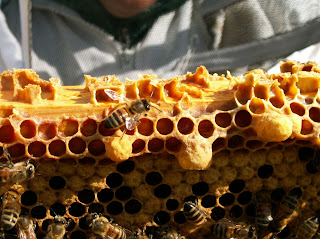Images and notes from a hive inspection and 'bailey comb change' in progress. The purpose of the bailey change is to make the honey bees create a new brood layer in which the frames have freshly drawn out wax honeycomb. If the bees create the new comb, the old brood box, with diseased honeycomb, can be removed and disposed of.
Saturday 4th May 2013.
A queen bee excluder on top of a new brood box containing 5 brood frames.
The new brood box is on top of the old brood box with a queen bee excluder between them.
On 28th April we put the queen bee on an old brood frame in the new brood box.
In the week 28th April to 4th May we were advised we should not yet have placed an excluder between the old and new brood boxes. We were also advised to make up a full complement of brood frames in the new brood box.
The inspection of 4th May was to find out what was happening and make the advised adjustments to the bailey comb change process.
The bees had not, as shown in the 28th April post, created new honeycomb in the gaps between the new frames and the wall of the new brood box. We think this may be due to the presence of the queen excluder (the mesh) between the boxes.
We put more frames in the new brood box. There are 11 frames with wired printed wax foundation and one partition board. The bees are clustered around the middle 3 frames. One of those 3 frames is an old frame from the old brood box.
We found the queen bee on one of the new frames on which a lot of new wax comb had been formed or 'drawn out'.
Our queen is a Buckfast bee and she was introduced to the colony last year. The colony was 'queenless' for a short period prior to her introduction.
New comb formation on the 3rd of the middle frames. There was also some comb formation on the outer faces of the 3 middle frames.
Below, the image shows the old frame in which there is plenty of capped worker brood.
We followed the advice given to us and removed the lower queen excluder and inspected the old brood box to assess the state of the brood, and search for queen cells.
We put the brood boxes back together without the queen excluder between them - meaning the queen bee can move back down into the old brood box and continue laying there. What we want is for the colony to continue creating new comb on the frames in the new brood box. We are maintaining a feed of 1:1 sugar syrup to encourage this. Our National hive has a 'super' (shallow box) above the new brood box in which there are super frames with capped and uncapped honey stores. The syrup feeder has been placed on top of the crown board at the top of the hive. We are using a 'super' as an 'eke'.
In the week 28th April to 4th May, the colony used up all the syrup feed - c.1litre. We were concerned there appeared to be some incomplete or inadequate processing of the syrup. Below is an image of one of the super frames (between the feeder and new brood box) showing a detail of freshly made honey(?) stores.
How does an intervention involving the introduction of an 'artificial' or unnatural food source affect the functioning of the worker bees in terms of their roles as 'hive bees' and 'field bees' - the latter being those that go out and forage for pollen and for nectar?
Why don't worker bees combine pollen foraging and nectar foraging?
24 hours later, a short observation of the hive.











No comments:
Post a Comment